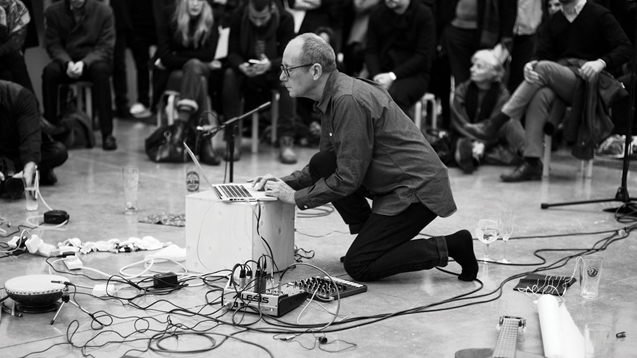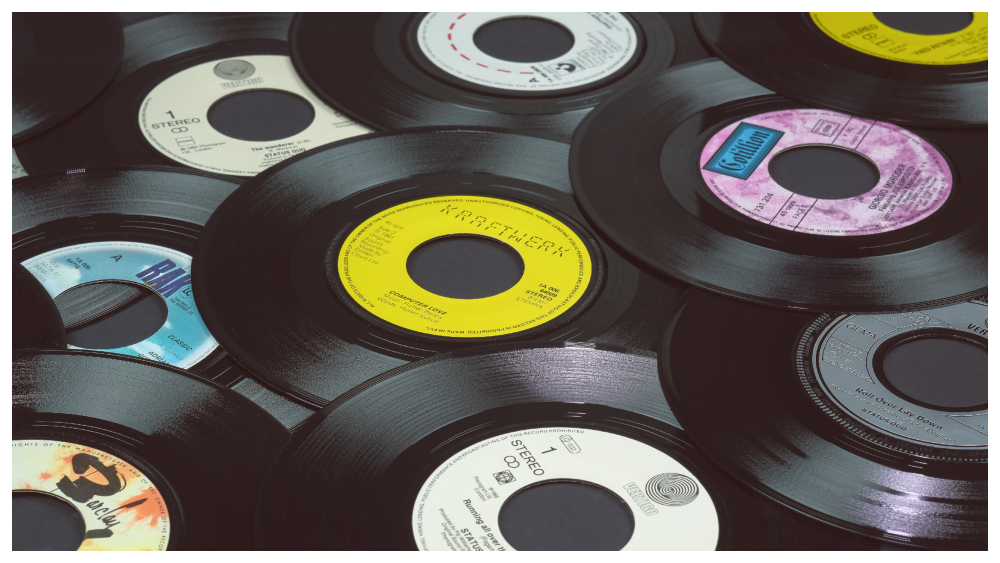More and more musicians are downing instruments in favour of capturing the natural noises outside their studio. Anita Awbi delves into their sonic world…
It’s 1952, a long, damp evening at the end of August. People are filing into the Maverick Concert Hall near Woodstock, Upstate New York, for a premiere unlike any other. Pianist David Tudor walks over to his instrument, sits down and begins – by shutting the keyboard lid. Twice more he opens and closes it, signalling the end of one movement and the start of another – but the audience hears no music. Not one note. The piece is John Cage’s 4’33”, and its silent echoes still reverberate today.
‘It’s a strange, complex and difficult piece in a way, but in another it’s extremely simple,’ says British composer, producer, author and innovator David Toop. He’s devoted his life to the exploration of sound and music, pioneering new norms along the way.
‘It’s a framing of listening within a particular setting, where you’d normally expect to hear music that’s deliberately separate from the environment: a shocking gesture in one sense,’ he continues. ‘But in another, it forces the audience to listen to the world around them, and consider those noises as performance.’
Before 4’33”, musicians drew influence from the outside world – emulating noises from nature and industry – ‘but the big difference in the 20th century was technology,’ says David.
‘It became possible to record sounds from outside. The fact that these noises also began existing as recordings suggested you could use them as they were - not by imitating them with an oboe, but by actually bringing in the sounds themselves.’
Although John Cage’s piece caused a scandal, he helped open the sonic sluices at a time when technology was catching up, shifting the parameters of recorded music forever.
It’s 1952, a long, damp evening at the end of August. People are filing into the Maverick Concert Hall near Woodstock, Upstate New York, for a premiere unlike any other. Pianist David Tudor walks over to his instrument, sits down and begins – by shutting the keyboard lid. Twice more he opens and closes it, signalling the end of one movement and the start of another – but the audience hears no music. Not one note. The piece is John Cage’s 4’33”, and its silent echoes still reverberate today.
‘It’s a strange, complex and difficult piece in a way, but in another it’s extremely simple,’ says British composer, producer, author and innovator David Toop. He’s devoted his life to the exploration of sound and music, pioneering new norms along the way.
‘It’s a framing of listening within a particular setting, where you’d normally expect to hear music that’s deliberately separate from the environment: a shocking gesture in one sense,’ he continues. ‘But in another, it forces the audience to listen to the world around them, and consider those noises as performance.’
Before 4’33”, musicians drew influence from the outside world – emulating noises from nature and industry – ‘but the big difference in the 20th century was technology,’ says David.
‘It became possible to record sounds from outside. The fact that these noises also began existing as recordings suggested you could use them as they were - not by imitating them with an oboe, but by actually bringing in the sounds themselves.’
Although John Cage’s piece caused a scandal, he helped open the sonic sluices at a time when technology was catching up, shifting the parameters of recorded music forever.

Dots and loops
The influence of 4’33” can be heard in everything from Brian Eno and David Byrne’s early cut-and-paste tape manipulations to the stadium-filling industrial clangs of early Depeche Mode and more recently, Matthew Herbert’s playful use of crisp packets and copies of the Daily Mail for musical and political purposes.
Fast forward to 2017 and it’s no longer surprising that British dance music producer Bonobo’s top five album, Migrations, incorporates found sounds as diverse as an elevator in Hong Kong airport, rain in Seattle, a tumble dryer in Atlanta and a boat engine in New Orleans.
Found sound is making increasing sense in our digital age, where breaking down the ‘fourth wall’ via social media has never been easier. And with the growing synchronisation between sound and vision, listeners and creators are ever more attuned to noise as art.
‘In our contemporary electronically-mediated culture, people are very used to hearing the conventions of combining music with dialogue, sound effects and environmental sound,’ explains Marcus Leadley, a composer who teaches field recording courses at Goldsmiths University, London.
‘Film and advertising rely on audio to tell stories, convey emotion and support messages. It also works the other way around in real life, where hearing music in the street, the home or in transit is an aspect of everyday experience.’
More recently, Björk’s latest LP, Utopia, released in November, samples birds and insects, and draws directly from David Toop’s Hekura (1980) and its expanded reissue Lost Shadows: In Defence of the Soul (2015).
David, who was asked by Björk to identify any noises on the LP which might be his, says: ‘It’s part of a philosophy for her, I think, to soften the boundaries between humans and non-humans. It becomes a very important thing for somebody like her to include these different sounds… The music she’s making is very much in the digital domain, but then it’s full of birdsong, New Guinean sacred flutes, and so on.’
The influence of 4’33” can be heard in everything from Brian Eno and David Byrne’s early cut-and-paste tape manipulations to the stadium-filling industrial clangs of early Depeche Mode and more recently, Matthew Herbert’s playful use of crisp packets and copies of the Daily Mail for musical and political purposes.
Fast forward to 2017 and it’s no longer surprising that British dance music producer Bonobo’s top five album, Migrations, incorporates found sounds as diverse as an elevator in Hong Kong airport, rain in Seattle, a tumble dryer in Atlanta and a boat engine in New Orleans.
Found sound is making increasing sense in our digital age, where breaking down the ‘fourth wall’ via social media has never been easier. And with the growing synchronisation between sound and vision, listeners and creators are ever more attuned to noise as art.
‘In our contemporary electronically-mediated culture, people are very used to hearing the conventions of combining music with dialogue, sound effects and environmental sound,’ explains Marcus Leadley, a composer who teaches field recording courses at Goldsmiths University, London.
‘Film and advertising rely on audio to tell stories, convey emotion and support messages. It also works the other way around in real life, where hearing music in the street, the home or in transit is an aspect of everyday experience.’
More recently, Björk’s latest LP, Utopia, released in November, samples birds and insects, and draws directly from David Toop’s Hekura (1980) and its expanded reissue Lost Shadows: In Defence of the Soul (2015).
David, who was asked by Björk to identify any noises on the LP which might be his, says: ‘It’s part of a philosophy for her, I think, to soften the boundaries between humans and non-humans. It becomes a very important thing for somebody like her to include these different sounds… The music she’s making is very much in the digital domain, but then it’s full of birdsong, New Guinean sacred flutes, and so on.’

Sticks and stones
For experimental electronic artist Mira Calix, exploration of found sound and field recording wasn’t about inviting the outside world in, more that she was strapped for cash when she started out.
‘I didn’t have money for loads of gear, so I went out and recorded things because I could make instruments out of them. Where other people were using drum machines, I was making rhythm sections from sticks and stones. It created something distinctive – and that’s how it all began for me.’
Since then, Mira has won a stack of awards and increasingly prestigious commissions. First emerging in around 2006, she says she’s noticed a growing appetite for interesting sonics from both the commissioning and listening worlds.
‘There’s more found sound creeping into everything, even pop music. These are often natural sounds, such as waterfalls or birds, and they give the music atmosphere. Inadvertently, they’re giving listeners an expanded sound palette too,’ she says.
‘For me, I wanted to get oxygen into my studio work. I’d leave a microphone hanging out the window because I wanted to add air into what was, and still is, a very digital format. I literally recorded air,’ Mira explains.
For experimental electronic artist Mira Calix, exploration of found sound and field recording wasn’t about inviting the outside world in, more that she was strapped for cash when she started out.
‘I didn’t have money for loads of gear, so I went out and recorded things because I could make instruments out of them. Where other people were using drum machines, I was making rhythm sections from sticks and stones. It created something distinctive – and that’s how it all began for me.’
Since then, Mira has won a stack of awards and increasingly prestigious commissions. First emerging in around 2006, she says she’s noticed a growing appetite for interesting sonics from both the commissioning and listening worlds.
‘There’s more found sound creeping into everything, even pop music. These are often natural sounds, such as waterfalls or birds, and they give the music atmosphere. Inadvertently, they’re giving listeners an expanded sound palette too,’ she says.
‘For me, I wanted to get oxygen into my studio work. I’d leave a microphone hanging out the window because I wanted to add air into what was, and still is, a very digital format. I literally recorded air,’ Mira explains.

New soundways
Susso is a found sound-based project that arose from curiosity, not necessity. It was masterminded by Welsh songwriter, producer and bassist Huw Bennett (above, left) after a trip to Gambia, and resulted in the cracking album, Keira, for Soundway Records last year.
A mish-mash of field recordings, guided by Mandinka musician Yusupha Suso and his extended family, it also includes found sounds recorded on street corners, in homes and on the beach, which Huw over-dubbed with his own playing. The results are seamless, thrumming with immersive Highlife, pounding rhythms and joyous melodics.
Now plotting a follow-up under the Minyanta moniker, due early 2018, he’s considering his continued pull towards found sound. ‘I think it adds a folk music element – it brings people and place into the mix. The Susso record was attached to family and culture within a folk landscape, and that’s how it works.
‘In the past, folk music wasn't put on at [the] Kings Place [concert hall] or somewhere like that – it was performed in pubs and on the streets. It naturally incorporated the atmospheres and conversations surrounding it – and these are the sounds that add identity to music, geographical, social and creative,’ he continues.
Oceans of sound
Global travel and cultural exchange are driving a growing use of found sound and field recordings within British music. It’s never been cheaper or easier to get out in the world with high definition recording equipment to capture your surroundings.
Australian-Taiwanese pianist and classical composer Belle Chen (main picture), who now resides in London, has been drawing on recent travel experiences across the Mediterranean, and the British and French capitals, for her latest album series. Bestowed with the honour of being tipped by Brian Eno, her music is unbound by tradition, often combining classical repertoire with recorded soundscapes.
‘When I look at a photograph and try to remember how it felt to be there, all I see is the pretty picture. But when I listen to a sound I recorded on my phone, the memory it evokes is deep,’ says Belle. ‘I can remember how I felt, the people I met and the conversations I had. In a way, these locations become my duetting partner, my co-performer.’
Belle began by manipulating soundbites because she wanted to ‘disintegrate’ convention and make her music more intimate. ‘I felt I could communicate my story better, not just convey Chopin or a collage of moods,’ she explains.
Interspecies collaborations
The list of British experimenters to mine this rich organic seam are too many to mention here, but Matthew Herbert collaborator and wayward alt-pop experimentalist Cosmo Sheldrake is definitely holding the torch for 2018.
The PRS Foundation-supported found sound evangelist creates ecstatic sound collages drenched in trippy Through the Looking Glass undertones. Following five years of incubation, his debut album, The Much Much How How and I, will drop in April. It was written under the influence of a diverse group of musicians – from The Kinks to Moondog to Herbert – and was shaped by his study of anthropology at university.
A love letter to the natural world, it follows the Tedx talk he gave back in 2013 - Interspecies Collaboration – which included a symphony of natural sounds alongside his own vocal improvisations.
‘For me, found sound and field recording is another kind of storytelling,’ he says. ‘I like the denseness and complexity of it. You’re never capturing just one thing. You’re capturing a whole ecosystem or web of complex relationships, which tell their own stories.’
Cosmo talks of textures and characters, clearly animated by the process of allowing the wild into his work. ‘For me it’s almost easier,’ he says. ‘It’s more of a collaboration. When you remove a sound from its setting and introduce it to another sound from another context, suddenly a whole new conversation opens up.’
Susso is a found sound-based project that arose from curiosity, not necessity. It was masterminded by Welsh songwriter, producer and bassist Huw Bennett (above, left) after a trip to Gambia, and resulted in the cracking album, Keira, for Soundway Records last year.
A mish-mash of field recordings, guided by Mandinka musician Yusupha Suso and his extended family, it also includes found sounds recorded on street corners, in homes and on the beach, which Huw over-dubbed with his own playing. The results are seamless, thrumming with immersive Highlife, pounding rhythms and joyous melodics.
Now plotting a follow-up under the Minyanta moniker, due early 2018, he’s considering his continued pull towards found sound. ‘I think it adds a folk music element – it brings people and place into the mix. The Susso record was attached to family and culture within a folk landscape, and that’s how it works.
‘In the past, folk music wasn't put on at [the] Kings Place [concert hall] or somewhere like that – it was performed in pubs and on the streets. It naturally incorporated the atmospheres and conversations surrounding it – and these are the sounds that add identity to music, geographical, social and creative,’ he continues.
Oceans of sound
Global travel and cultural exchange are driving a growing use of found sound and field recordings within British music. It’s never been cheaper or easier to get out in the world with high definition recording equipment to capture your surroundings.
Australian-Taiwanese pianist and classical composer Belle Chen (main picture), who now resides in London, has been drawing on recent travel experiences across the Mediterranean, and the British and French capitals, for her latest album series. Bestowed with the honour of being tipped by Brian Eno, her music is unbound by tradition, often combining classical repertoire with recorded soundscapes.
‘When I look at a photograph and try to remember how it felt to be there, all I see is the pretty picture. But when I listen to a sound I recorded on my phone, the memory it evokes is deep,’ says Belle. ‘I can remember how I felt, the people I met and the conversations I had. In a way, these locations become my duetting partner, my co-performer.’
Belle began by manipulating soundbites because she wanted to ‘disintegrate’ convention and make her music more intimate. ‘I felt I could communicate my story better, not just convey Chopin or a collage of moods,’ she explains.
Interspecies collaborations
The list of British experimenters to mine this rich organic seam are too many to mention here, but Matthew Herbert collaborator and wayward alt-pop experimentalist Cosmo Sheldrake is definitely holding the torch for 2018.
The PRS Foundation-supported found sound evangelist creates ecstatic sound collages drenched in trippy Through the Looking Glass undertones. Following five years of incubation, his debut album, The Much Much How How and I, will drop in April. It was written under the influence of a diverse group of musicians – from The Kinks to Moondog to Herbert – and was shaped by his study of anthropology at university.
A love letter to the natural world, it follows the Tedx talk he gave back in 2013 - Interspecies Collaboration – which included a symphony of natural sounds alongside his own vocal improvisations.
‘For me, found sound and field recording is another kind of storytelling,’ he says. ‘I like the denseness and complexity of it. You’re never capturing just one thing. You’re capturing a whole ecosystem or web of complex relationships, which tell their own stories.’
Cosmo talks of textures and characters, clearly animated by the process of allowing the wild into his work. ‘For me it’s almost easier,’ he says. ‘It’s more of a collaboration. When you remove a sound from its setting and introduce it to another sound from another context, suddenly a whole new conversation opens up.’

Recording rules
For visual artist and musician Larry Achiampong, field recordings allow him to explore his cultural identity, heritage and class through sound. He was brought up in East London to Ghanaian parents, and has been influenced by their old Highlife LPs, the music at his mother’s church and the sample-based sounds of jazz/hip-hop producer Madlib.
In 2016, for a year-long residency at the British Library Sound Archive, he was given access to the Christ Reformed Church in Peckham, South London, to record their songs and sermons. The residency, and subsequent album, Untitled, inspired him to consider the importance of audio within the historical legacy we’re leaving for future generations.
In a career spanning different media, countries and cultures, he’s acutely aware of the misappropriation of sound and meaning in modern music – the major downside to using field recordings indiscriminately.
‘There are often appropriation issues in music, especially with field recordings and found sound,’ he confirms. ‘If you look at our reference libraries, there are often colonial undertones in there.’
For Larry, it’s about ensuring all avenues are properly explored and accurately represented. ‘I think working class communities have been doing that for a long time,’ he continues.
‘If you look at the history of hip-hop through to jungle and house music, people have been co-opting incredible sounds with the intention of generating good vibes and building upon a culture – and that’s the base angle I’m coming from. I’m not interested in the hierarchy of sound, where you need certain knowledge and access. It’s all about the love of sound and respecting where it comes from.’
This article featured in the M66 issue of M Magazine
For visual artist and musician Larry Achiampong, field recordings allow him to explore his cultural identity, heritage and class through sound. He was brought up in East London to Ghanaian parents, and has been influenced by their old Highlife LPs, the music at his mother’s church and the sample-based sounds of jazz/hip-hop producer Madlib.
In 2016, for a year-long residency at the British Library Sound Archive, he was given access to the Christ Reformed Church in Peckham, South London, to record their songs and sermons. The residency, and subsequent album, Untitled, inspired him to consider the importance of audio within the historical legacy we’re leaving for future generations.
In a career spanning different media, countries and cultures, he’s acutely aware of the misappropriation of sound and meaning in modern music – the major downside to using field recordings indiscriminately.
‘There are often appropriation issues in music, especially with field recordings and found sound,’ he confirms. ‘If you look at our reference libraries, there are often colonial undertones in there.’
For Larry, it’s about ensuring all avenues are properly explored and accurately represented. ‘I think working class communities have been doing that for a long time,’ he continues.
‘If you look at the history of hip-hop through to jungle and house music, people have been co-opting incredible sounds with the intention of generating good vibes and building upon a culture – and that’s the base angle I’m coming from. I’m not interested in the hierarchy of sound, where you need certain knowledge and access. It’s all about the love of sound and respecting where it comes from.’
This article featured in the M66 issue of M Magazine

.ashx?h=67&w=80&la=en&hash=340524FD746527338490DF251ABF8B71)



